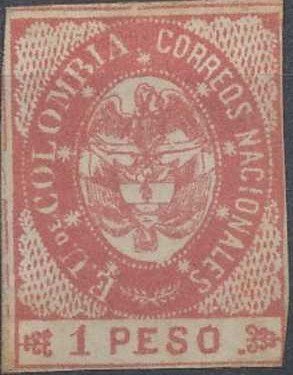Stamp: Coat of Arms (Colombia 1865)
Coat of Arms (Colombia 1865)
01 January (Colombia ) within release 1865 Definitives: Arms of Colombia goes into circulation Stamp Coat of Arms face value 1 Colombian peso
| Stamp Coat of Arms in catalogues | |
|---|---|
| Michel: | Mi: CO 32b |
| Stamp Number: | Sn: CO 42a |
| Yvert et Tellier: | Yt: CO 33a |
Stamp is square format.
Six different types exists. Possible color variations. Yvert color: carmine Lithographed on white, and also on bluish-white wove paper, rather thin. There are nine lines of shading in the top compartment of the shield, if those be reckoned which run into the middle peak of the shield. The cap of Liberty, though small, is very distinct, and shaded with oblique lines running down from right to left. The two seas in the bottom compartment are both larger than the isthmus which separates them. There is a distinct ship in the lower sea, and a mark something like a ship in the upper one. The label or ribbon above the top of the shield is bent down in the middle so as to touch the top point of the shield ; and the forked ends of the ribbon do not touch the oval outside them. The neck of the condor is very much narrower than the width of the ribbon. The eye is very small and round, and there is a distinct ring of white feathers round the base of the neck. There are eighty-nine little pearls round the white oval. They are all distinct, and moderately uniform in size and shape. Between these pearls and the inscription there are nine eight-pointed asterisks or stars, placed in the following positions: the first is exactly above the head of the bird, and one of its points touches the stop after "Colombia" ; the second comes below the space between "RE" of "CORREOS" ; the third below "NA" of "NACIONALES" ; the fourth below "ON" of "NACIONALES" ; the fifth below "s" of "NACIONALES" ; the sixth under "E" ; the seventh under the "E" of "DE"; the eighth under the "L" of "COLOMBIA" ; and the ninth below "MB" of "COLOMBIA". There is a stop after the words "E.U, COLOMBIA" and "CENT or PESO", but none after the other words. At the bottom of the coloured oval there are two little white branches, very easily seen, and with their bottom ends crossing. All the lettering is distinct, and the letters nicely formed. The "A" of "COLOMBIA" is pointed at the top.Also in the issue 1865 Definitives: Arms of Colombia:
- Stamp - Coats of Arms face value 5;
- Stamp - Coats of Arms face value 1;
- Stamp - Coats of Arms face value 50;
- Stamp - Coat of Arms face value 1;
|
Data entry completed
56%
|
|
|---|---|
| Stamp Coat of Arms in digits | |
| Country: | Colombia |
| Date: | 1865-01-01 |
| Print: | Lithography |
| Perforation: | Imperforate |
| Emission: | Definitive |
| Format: | Stamp |
| Face Value: | 1 Colombian peso |
Stamp Coat of Arms it reflects the thematic directions:
Animals are multicellular, eukaryotic organisms of the kingdom Animalia (also called Metazoa). All animals are motile, meaning they can move spontaneously and independently, at some point in their lives. Their body plan eventually becomes fixed as they develop, although some undergo a process of metamorphosis later on in their lives. All animals are heterotrophs: they must ingest other organisms or their products for sustenance.
Birds (Aves), a subgroup of Reptiles, are the last living examples of Dinosaurs. They are a group of endothermic vertebrates, characterised by feathers, toothless beaked jaws, the laying of hard-shelled eggs, a high metabolic rate, a four-chambered heart, and a strong yet lightweight skeleton. Birds live worldwide and range in size from the 5 cm (2 in) bee hummingbird to the 2.75 m (9 ft) ostrich. They rank as the class of tetrapods with the most living species, at approximately ten thousand, with more than half of these being passerines, sometimes known as perching birds. Birds are the closest living relatives of crocodilians.
A coat of arms is an heraldic visual design on an escutcheon (i.e. shield), surcoat, or tabard. The coat of arms on an escutcheon forms the central element of the full heraldic achievement which in its whole consists of shield, supporters, crest, and motto. A coat of arms is traditionally unique to an individual person, family (except in the United Kingdom), state, organisation or corporation.
A vulture is a bird of prey that scavenges on carrion. There are 23 extant species of vulture (including condors). Old World vultures include 16 living species native to Europe, Africa, and Asia; New World vultures are restricted to North and South America and consist of seven identified species, all belonging to the Cathartidae family. A particular characteristic of many vultures is a bald, unfeathered head. This bare skin is thought to keep the head clean when feeding, and also plays an important role in thermoregulation




